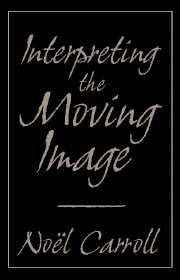Book contents
- Frontmatter
- Contents
- Foreword: Through Carroll's Looking Glass of Criticism
- Introduction
- 1 The Cabinet of Dr. Kracauer
- 2 Entr'acte, Paris and Dada
- 3 The Gold Rush
- 4 Keaton: Film Acting as Action
- 5 Buster Keaton, The General, and Visible Intelligibility
- 6 For God and Country
- 7 Lang, Pabst, and Sound
- 8 Notes on Dreyer's Vampyr
- 9 King Kong: Ape and Essence
- 10 Becky Sharp Takes Over
- 11 Interpreting Citizen Kane
- 12 The Moral Ecology of Melodrama: The Family Plot and Magnificent Obsession
- 13 Mind, Medium, and Metaphor in Harry Smith's Heaven and Earth Magic
- 14 Welles and Kafka
- 15 Nothing But a Man and The Cool World
- 16 Identity and Difference: From Ritual Symbolism to Condensation in Anger's Inauguration of the Pleasure Dome
- 17 Text of Light
- 18 Joan Jonas: Making the Image Visible
- 19 Introduction to Journeys from Berlin/1971
- 20 The Future of Allusion: Hollywood in the Seventies (and Beyond)
- 21 Back to Basics
- 22 Amy Taubin's Bag
- 23 Herzog, Presence, and Paradox
- 24 Film in the Age of Postmodernism
- Notes
- Index
6 - For God and Country
Published online by Cambridge University Press: 05 June 2012
- Frontmatter
- Contents
- Foreword: Through Carroll's Looking Glass of Criticism
- Introduction
- 1 The Cabinet of Dr. Kracauer
- 2 Entr'acte, Paris and Dada
- 3 The Gold Rush
- 4 Keaton: Film Acting as Action
- 5 Buster Keaton, The General, and Visible Intelligibility
- 6 For God and Country
- 7 Lang, Pabst, and Sound
- 8 Notes on Dreyer's Vampyr
- 9 King Kong: Ape and Essence
- 10 Becky Sharp Takes Over
- 11 Interpreting Citizen Kane
- 12 The Moral Ecology of Melodrama: The Family Plot and Magnificent Obsession
- 13 Mind, Medium, and Metaphor in Harry Smith's Heaven and Earth Magic
- 14 Welles and Kafka
- 15 Nothing But a Man and The Cool World
- 16 Identity and Difference: From Ritual Symbolism to Condensation in Anger's Inauguration of the Pleasure Dome
- 17 Text of Light
- 18 Joan Jonas: Making the Image Visible
- 19 Introduction to Journeys from Berlin/1971
- 20 The Future of Allusion: Hollywood in the Seventies (and Beyond)
- 21 Back to Basics
- 22 Amy Taubin's Bag
- 23 Herzog, Presence, and Paradox
- 24 Film in the Age of Postmodernism
- Notes
- Index
Summary
The critique of religion is the prerequisite of all criticism.… The foundation of this critique is the following: man makes religion, religion does not make man.
–Karl Marx, Contribution to the Critique of Hegel's Philosophy of Right (opening lines)The critique of competitive capitalism, in Marx, is motivated by a root concern with the topic of alienation, or, rather more abstractly, with the relation between human activity and human accomplishment. Human activity creates a range of “objects” including not only trucks and trains but social systems, values, technologies. Though these “objects” are originally fabricated for the gratification of man, within the historical process, these “objects” become independent of their original function. That is, more concretely, the state or the exchange system evolves from the role of service institution for the needs of man to autonomous entities whose needs must be served by man. Within the historical context, the state comes to presuppose war or the possibility of war as a basic justification of its existence. Hence, conscription. Dialectically, the need of the state has come to supersede the needs of man. The products of human activity come to enslave human activity.
For Marx, this process of inversion, alienation, is paradigmatically represented by religion. For religion is a product of man. Yet, it dominates man not only as a social institution; it inverts the relation of man and god cosmologically. Man made god; yet religion posits that god makes man.
- Type
- Chapter
- Information
- Interpreting the Moving Image , pp. 80 - 91Publisher: Cambridge University PressPrint publication year: 1998
- 1
- Cited by

